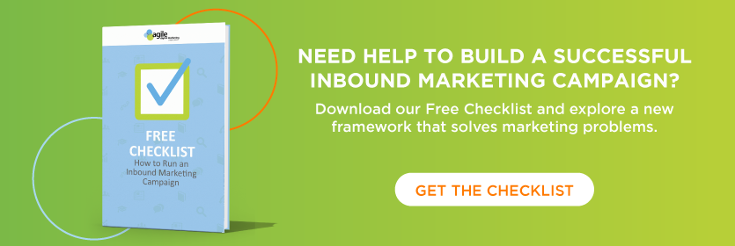Over the years, our team spent a lot of time learning, experimenting, testing, and applying what works and what doesn't when it comes to building a successful marketing campaign. And where we find interesting is that pretty much anything can work: content marketing, email marketing, PPC, or even good old fashioned direct mail.
What actually separates the winners from the losers isn't the tactic, but the underlying strategy behind the method. This is why it's so important to set yourself up for success right from the start by mapping out and planning your campaign from start to finish.
Make sure you're doing these steps to build a successful inbound marketing campaign! Access our free resource here
With all that said, let’s dive into the 5 key steps to build a successful marketing campaign.
1. Set your goals and objectives
One of the craziest things we see is the creation of a marketing campaign just because. Or, in other words, random acts of marketing without any clear goal or objective behind the campaign. It's probably not hard to believe that when this happens, you're pretty much doomed before you've even started.
It's rare that a campaign gets launched and has any chance of being successful without clearly articulating where you want it to go and what success would look like. Here are some questions to ask yourself at this point:
● Why are we doing this?
● What are we hoping to achieve?
● What's the end goal?
● How will we know if we're successful or not?
2. Identify what are you going to promote
Now that you've got your reasons all sorted out, it's time to analyze what you're about to promote. One of the biggest mistakes often made and one of the surest ways to have complete marketing failure is to market something that you want, rather than what the market wants.
At this stage, you should get absolutely clear about what the best thing is to promote right now.
If you're marketing to a brand new, cold audience who has no idea who you are, you may want to start with something that has a low-barrier and high perceived value. It will make it easier to market and, consequently, to sell.
If, on the other hand, you're marketing to a warm audience of people who already know you or returning customers, you can start moving further up the customer ladder and market something higher on your value ladder.
Regardless, some of the essential questions you should ask yourself at this point are:
● What are we trying to promote?
● Is this something we should be promoting?
● Do we think the audience wants this?
● What might they want more instead?
3. Know your offer and your customers
Once you've set your goals and decided what you'll be promoting, it's time to know your offer and your customers.

The reason to do this is that you want to find the overlap between your offer and your customers and find a strategy to match them together in a way that uniquely solves their problems.
More exactly, the goal of this part is to uncover your customers' wants, dreams, fears, needs, issues, frustrations, etc. and then find a way that your business (your offer) uniquely solves this problem for them.
Afterward, demonstrate how you can bridge the gap to get them from where they are to where they want to go.
Some questions to ask yourself at this step:
● Who are we trying to serve?
● Do we know the basic information about them? (age, gender, occupation, location, and so on)
● What about the deeper details? (attitudes, interests, beliefs, and so on)
4. Choosing the channels of communication
By this step, you should have a clear understanding of what you're going to promote and who you're promoting it to. So now it's the perfect time to actually begin displaying the message in front of the customers. However, in order to do that, you first need to know where your customers are so you can meet them there.

Fortunately, armed with all the information that you've collected by going through the previous steps, finding out these details is fairly easy.
It just takes a Google search on which demographics tend to be using which social media networks, and you'll have a really good baseline of where to start.
Questions to ask yourself at this point are:
● Where do my customers spend their time, online and offline?
● What social media platforms do they use?
● How do they prefer to engage with online content?
● What kind of content do they prefer?
5. Figuring out how to launch and manage the campaign
Mistakenly, this is where most people start and it often leads to marketing campaigns that are built on shaky foundations with no real strategy.
After all, how can you possibly know the best way to launch and manage your marketing campaign until you've clearly identified the goals, the customers, the offer, and where you're going to run the campaign? You can't, which is why plenty of marketing campaigns fail.
The key is to go through the steps that we've just covered and by the time you get to this stage, you simply need to decide on what tactic to execute on.
As an example, let's say that you've determined that your audience is on Instagram and Instagram Ads will be the best way to reach them there.
This step comes down to figuring out how to run Instagram Ads or finding someone that knows. Or, if you've determined that your market is on YouTube, thus the best way to reach them there is a YouTube content strategy.
Well, you just need to research what's the best way to run a YouTube content strategy and if you should run YouTube ads, as well.
In most cases, some clever questions to ask yourself are:
- How will we do this?
- Should we do it ourselves or ask for help?
- What do we need to know, have, or do to make this campaign work?
Schedule a FREE consultation with our team of experts and we'll be happy to build, launch, and manage a successful marketing campaign. Let's get in touch!

